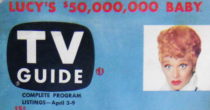Today marks the 65th anniversary of commercial color TV. CBS aired a special hour-long color spectacular called “Premiere” on Monday, June 25th, 1951. It aired on just five stations: WCBS-TV (New York City), WNAC-TV (Boston), WCAU-TV (Philadelphia), WMAR-TV (Baltimore), and WTOP-TV (Washington). It was broadcast using the CBS field-sequential color system, which the FCC adopted in October 1950 even though it was totally incompatible with existing black-and-white sets.
When CBS began color broadcasting, adapters allowing existing black-and-white sets to pick up its color broadcasts weren’t available yet. Two different adapters were in the works: one that let black-and-white sets pick up CBS color broadcasts in black-and-white and another that made it possible for black-and-white sets to receive the color programs in color.
Sponsors & Stars
CBS lined up 16 sponsors for “Premiere,” which at the time may have been the largest number of sponsors involved in a single network program: General Mills; Longines-Wittnauer; Pabst Blue Ribbon Beer; William Wrigley Jr. Co; Revlon; Thomas J. Lipton Inc.; National Biscuit Co.; Toni Home Permanent; Monarch Finer Foods; Procter & Gamble; Standard Brands; Quaker Oats; Best Foods; Pepsi-Cola; Liggett & Myers (Chesterfields).
The all-star cast included Arthur Godfrey, Faye Emerson, Sam Levenson, Garry Moore, Patty Painter, Robert Alda, Isabel Bigley, Cora and Bil Baird and the Baird Marionettes, and members of the New York City Ballet. Also on hand were CBS Chairman William S. Paley, CBS President Frank Stanton, and FCC Chairman Wayne Coy. Fred Rickey was the executive producer, Frances Buss the director.
“Premiere” aired live from 4:35PM to 5:30PM. According to Broadcasting*Telecasting, CBS estimated that between 35,000 and 40,000 people watched in the five cities where it was broadcast. The network set up viewing stations in each city for invited guests, as did a few TV manufacturers in New York City. Some members of the general public also tuned in thanks to homemade color adapters.
Reviews Mixed
Broadcasting*Telecasting was mostly positive in its review of “Premiere.” The publication praised the New York City Ballet segment, the Revlon and Pabst Blue Ribbon Beer commercials, and color TV itself:
“There can’t be any doubt that for advertisers color TV will do as much as the best color reproductions in slick magazines, and far more than color in newspapers. Assuming technical difficulties do not restrain it, color television seems destined to become the major TV service.
The Billboard ran a lengthy review in its June 30th issue based on rehearsals. A review of the actual broadcast followed on July 7th, calling Garry Moore and Durward Kirby “the highlight comedy spot of the show.” The New York City Ballet was the “most effective over-all portion” of the special. There were, however, significant problems with the lighting:
Arthur Godfrey’s face, for example, changed color as he moved toward and away from the camera, and in and out of the best lighting range. Faye Emerson’s chignon and natural hair, occasionally didn’t seem to match. CBS President Frank Stanton and Board Chairman Bill Paley seemed to be wearing green suits, tho actually they were clothed in gray.
The New York Times was more critical, lamenting how the general public couldn’t watch the special while also pointed out on problems with the lighting:
Although the C.B.S. color system was demonstrated for the public last fall on an experimental basis, yesterday’s show indicated for the first time that the facial appearances of actors in color TV are highly sensitive to lighting, particularly when the actors move around. The flesh tones varied considerably when the personalities moved their heads.
Observers noted that when the actors looked toward the overhead lights, their faces were inclined to “wash out.” When they turned away from the lights, their flesh tones became darker. This is not a defect of the color system, however, but a problem calling for extreme care in lighting the studio.
No recordings of “Premiere” or any other CBS color programs are known to exist. In its July 23rd, 1951 issue LIFE published six color photographs taken from a TV set to demonstrate CBS color television. At least four of these pictures are from “Premiere” and feature Arthur Godfrey, Ed Sullivan, ballet dancers, and the Pabst beer commercial.
The End of CBS Color
The day after “Premiere” aired, CBS introduced a limited color schedule. Six additional stations eventually began airing color programming. Unfortunately for CBS, there were no sponsors willing to buy commercials during color programs. Also, no existing TV manufacture agreed to produce color sets. CBS had no choice but to buy a manufacture and sell its own set. Finally, the outbreak of the Korean War led the National Production Authority to officially ban production of color TV sets in November 1951. Shortly before that, CBS threw in the towel. Its last color broadcast was a football game on October 20th.
The late Ed Reitan, whose research into early color television can been found at the Early Television website, estimated that CBS aired 111 hours of color programming during the 17 weeks its color system was in operation. A compatible color system was eventually developed and adopted by the FCC in late 1953 and the CBS field sequential system was soon forgotten.
If anyone reading this remembers watching “Premiere” back in 1951, I’d love to hear your thoughts.
References:
“C.B.S. Color Video Presents a ‘First’.” New York Times. 26 Jun. 1951: 31.
“Commercial Color Kickoff.” Broadcasting*Telecasting. 2 Jul. 1951: 55.
Csida, Joe. “Preem and First 2 Regular CBShows Tip Color Advantages, Problems.” The Billboard. 7 Jul. 1951: 3; 6.
“In Review…” Broadcasting*Telecasting. 2 Jul. 1951: 28.






Not old enough to remember “Premiere”, but I am a little puzzled that the FCC approved a color TV system that was incompatible with existing black-and-white sets.
What would have happened if Peter Goldmark had been able to perfect a field-sequential color television system that could have been seen in black-and-white on black-and-white sets?? Would set makers—even RCA–have eventually made field-sequential color sets??
Probably the reason is that CBS’s system was so much better than NBC color early on that waiting for compatibility would seemingly have delayed color for a decade–if NBC’s system could work at all. Only an all out color effort by NBC allowed them to get a superior picture by 1951. (I’m basing this on the excellent book “Tube: The Invention of Television” which has an excellent section on the “color wars”.)
Another question is “why on earth did CBS sink all this money and effort into Goldmark’s system but not try to line up manufacturers?” I’ve even heard theories CBS’s real motive was to stall the progress of television until it could catch up with NBC’s big lead.
Last but far from least, when CBS went to full color in the lste sixties….it was the best color quality in broadcasting. .NBC sucked…always had a bluish overcast. ABC was evan worst. ..green overcast that nearly drowned out other colors. Except cartoons…but they looked faded. CBS broadcasted bbrilliant color thsy was like the movies…of course as years past color improved in quality and richness.
Goldmark’s color system was, indeed, a delaying tactic by CBS. I recall reading that one CBS exec, when involved in some negotiations with other broadcast interests, came out in favor of some kind of compromise on color tv standards, they were quickly booted into exile at CBS.
Sarnoff based his empire on selling hardware and could loose money on color tv programming to get it off the ground. Paley didn’t have that luxury – he only had radio and tv network to bring in income.
In 1950-51, television was just starting to take off and it was an expensive proposition, requiring new facilities, equipment, and contracts for talent and content. By delaying color tv, Paley would have had time to pay off these capital expenses for black and white tv. He was squeezing everything he could from the radio network, raiding NBC for talent, to bring in the extra income to make the transition to television.
It’s too bad, by the way, that CBS didn’t think to make some kinescopes of the color broadcasts. It was possible to reconfigure a monitor to show all four components of the color image on one screen – these could have been recombined by modern archivists to see what the broadcasts were like.
If you look at any changes in TV it tends to take a while for them to be fully implemented. Stereo took time since most of the stuff that was being re-broadcasted was mono. Even many movies were only mono up until the 70s when to some degree Sensurround, Dolby and THX (particularly Star Wars) pushed stereo into theaters. In fact even though stereo technology had been around for some time it took quite a while before TVs went stereo. The need to catch up to the movies probably helped push TV towards stereo. (Which seemed like a “duh” moment at the time.)
The latest trend is towards 4K TV. But considering how expensive they currently are, the lack of broadcasted content and that we’ve relatively recently seen a vast quality improvement with the move to digital, it could take a decade or two for those to really catch on.
In the past they use to film color shows so they would work on B&W TVs. Nowadays, if you try to play a modern color show on a B&W analogue TV it can sometimes be hard to make out what’s going on. Of course part of that has to do with the way digital darkens everything down.